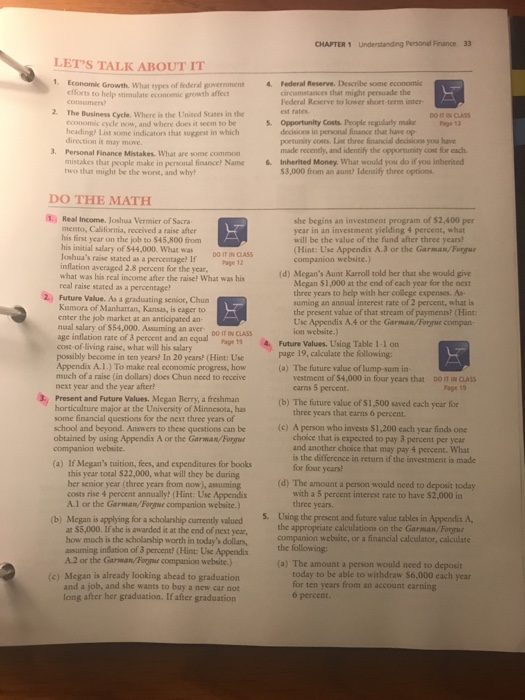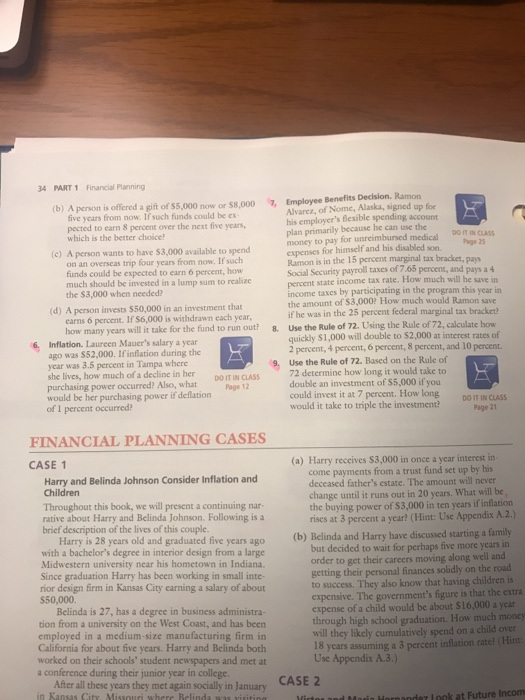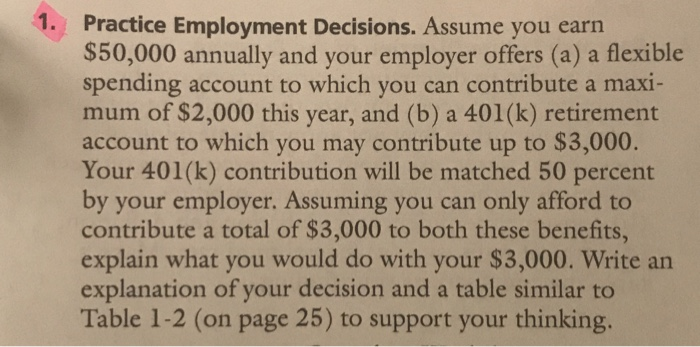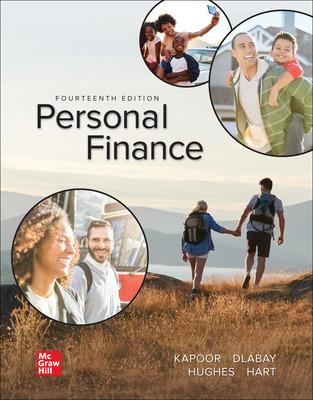Hi, i just need the highlighted ones. Thank you!

CHAPTER 1 Understanding Personal Finance 33 LET'S TALK ABOUT IT 1. Economic Growth. What tpes of federal government Federal Reserve. Describe some economic circumstances that might persuade the Federal Reserve to lower short-term inter- ctfoets to help stimulate economic growth affect 2 The Business Cycle. Where is the United States in the economic cycle now, and where does it seem to be heading? List some indicators that suggest in which direction it may move Opportunity Costs. People regularly make Pa 13 decisions in personal finance that have op portunity costs. List three financial decisions you have made recently, and identify the opportunity cont for each 3. Personal Finance Mistakes. What are some common mistakes that people make in personal finance two that might be the wort, and why! Name Inherited Money. What would you do if you inberited $3,000 from an aunt? ldentify three options DO THE MATH 1 Real Income. Joshua Vermier of Sacra mento, California, received a raise after his first year on the job to $45,800 from his initial salary of $44,000. What wa DO IT IN CLASS loshua's raise stated as a percentage? If ae 12 inflation averaged 2.8 percent for the year what was his real income after the raise? What was his real raise stated as a percentage she begins an investment program of $2,400 per year in an investment yielding 4 percent, what will be the value of the fund after three years (Hint: Use Appendix A.3 or the Garman/Forue companion website.) (d) Megan's Aunt Karroll told ber that she would give Megan $1,000 at the end of each year for the next three years to help with her college expenses. As suming an annual interest rate of 2 percent, what is the present value of that stream of payments? (Hint Usc Appendix A.4 or the Garman/Foryrwe compan- ion website.) 2 Future Value. As a graduating senior, Chun Kumora of Manhattan, Kansas, is eager to enter the job market at an anticipated an nual salary of $54,000. Assuming an aver po IT IN CLASS age inflation rate of 3 percent and an equal cost of-living raise, what will his salary possibly become in ten years? In 20 years? (Hint: Use Appendix A.1.) To make real economic progress, how much of a raise (in dollars) does Chun noed to receive next year and the year after? Present and Future Values. Megan Berry, a freshman horticulture major at the University of Minnesota, has some financial questions for the next three years of school and beyond. Answers to these questions can be obtained by using Appendix A or the Garman/Forgwe companion website Future Values. Using Table 1-1 on page 19, calculate the following: (a) The future value of lump-sum in vestment of S4,000 in four years that DO T IN CLASS Pape 19 3, (b) The future value of $1,500 saved each ycar for three years that carns 6 percent (c) A person who invests $1,200 cach year finds one choice that is expected to pay 3 percnt per year and another choice that may pay 4 percent. What is the difference in return if the investment is made for four years? (a) If Megan's tuition, fees, and expenditures for books this year total $22,000, what will they be during her senior year (three years from now), assuming costs rise 4 percent annually?(Hint: Use Appendix A.1 or the Garman/Forwe companion website.) (d) The amount a person would need to deposit today with a 5 percent interest rate to have $2,000 in three years. 5 (b) Megan is applying for a scholarship currently valued Using the present and future value tables in Appendix A, the appropriate calculations on the Garman/Foru ar $5,000. If she is awarded it at the end of next year how much is the scholarship worth in today's dollars, assuming inflation of 3 percent? (Hint: Use Appendix A2 or the Garman/ Forgme companion website.) companion website, or a financial calculator, calculare the following (a) The amount a person would nced to deposit today to be able to withdraw $6,000 each year for ten years from an account earning (c) Megan is already looking ahead to graduation and a job, and she wants to buy a new car not long after her graduation. If after graduation 34 PART 1 Financial Planning Employee Benefits Decision. Ramon Alvarez, of Nome, Alaska, signed up for his employer's flexible spending account plan primarily because he can use the money to pay for unreimbursed medicalICLASS expenses for himself and his disabled son Ramon is in the 15 percent marginal tax bracket, pays Social Security payroll taxes of 7.65 percent, and pays a 4 percent state income tax rate. How much will he save in income taxes by participating in the program this year in the amount if he was in the 25 percent federal marginal tax bracket (b) A person is offered a gift of $5,000 now or $8,000 five years from now. If such funds could be ex pected to earn 8 percent over the next five years which is the better choice? (c) A person wants to have $3,000 available to spend on an overseas trip four years from now. If such funds could be expected to earn 6 percent, how much should be invested in a lump sum to realize the $3,000 when needed of $3,000 How much would Ramon save (d) A person invests $50,000 in an investment that earns 6 percent. If $6,000 is withdrawn each year how many years will it take for the fund to run out? 8. Use the Rule of 72. Using the Rule of 72, calculate how quickly $1,000 will double to $2,000 at interest rates of 2 percent, 4 percent, 6 percent, 8 percent, and 10 percent Use the Rule of 72. Based on the Rule of 72 determine how long it would take to double an investment of $5,000 if you could invest it at 7 percent. How long 6. Inflation. Laureen Mauer's salary a year ago was S52,000. If inflation during the year was 3.5 percent in Tampa where she lives, how much of a decline in her 9. purchasing power occurred? Also, what DO IT I CLAS would be her purchasing power if deflation of 1 percent occurred? Page 12 y qu ss DO IT IN CLASS would it take to triple the investment FINANCIAL PLANNING CASES CASE 1 (a) Harry receives $3,000 in once a year interest in come payments from a trust fund set up by his deceased father's estate. The amount will never change untilit runs out in 20 ycars. What will be the buying power of $3,000 in ten years if inflation rises at 3 percent a year? (Hint: Use Appendix A.2.) Harry and Belinda Johnson Consider Inflation and Children Throughout this book, we will present a continuing nar rative about Harry and Belinda Johnson. Following is a brief description of the lives of this couplc. (b) Belinda and Harry have discussed starting a family Harry is 28 years old and graduated five years ago with a bachelor's degree in interior design from a large Midwestern university near his hometown in Indiana. Since graduation Harry has been working in small inte- rior design firm in Kansas City carning a salary of about $50,000. but decided to wait for perhaps five more years in order to get their careers moving along well and getting their personal finances solidly on the road to success. They also know that having children is expensive. The government's figure is that the extra expense of a child would be about $16,000 a year through high school graduation. How much money will they likely cumulatively spend on a child over 18 years assuming a 3 percent inflation rate? tion from a university on the West Coast, and has been employed in a medium-size manufacturing firm in California for about five years. Harry and Belinda both worked on their schools' student newspapers and met at a conference during their junior year in college ro a After all these years they met again socially in January victor nnd Moi Honandez Lonk at Future Incom 1. Practice Employment Decisions. Assume you earn $50,000 annually and your employer offers (a) a flexible spending account to which you can contribute a maxi mum of $2,000 this year, and (b) a 401(k) retirement account to which you may contribute up to $3,000 Your 401(k) contribution will be matched 50 percent by your employer. Assuming you can only afford to contribute a total of $3,000 to both these benefits, explain what you would do with your $3,000. Write an explanation of your decision and a table similar to Table 1-2 (on page 25) to support your thinking. did not get. vhat happenedu to cau b the nd Was there anything you could have done differently better to prepare? 2. Comparing Salary Offers. Using Equa- contions (2.1) or (2.2), if the cost-of-living er me y index was 132 for Chicago and 114 for San Antonio, compare the buying power a DO IT IN CLASS S50,000 salary in Chicago with a $47,000 6 ,000 offer in San Antonio. 3. Future Value of Employer's Match. Tyler Winkle's em- ployer in Pittsburgh makes a matching contribution of $2,000 a year to his 401(k) retirement account at work. If the dollar amount of the employer's contribution in creases 4 percent annually, how much will the employer contribute to the plan in the twentieth year from now? (Hint: See Appendix A.1.) Cashing Out 401(k) Plan. Emily Amarrada of Sioux City, South Dakota has accepted a new job and is thinking about cashing out the $30,000 she has built up in her employer's 401(k) plan to buy a new car. If, instead, she left the funds in the plan and they are projected to earn 6 percent annually for the next 30 years, how much would Emily have in her plan? (Hint: See DO IT IN CLASS Appendix A.1.) CLASS e 19 4. all Page 50 SES CASE 2











